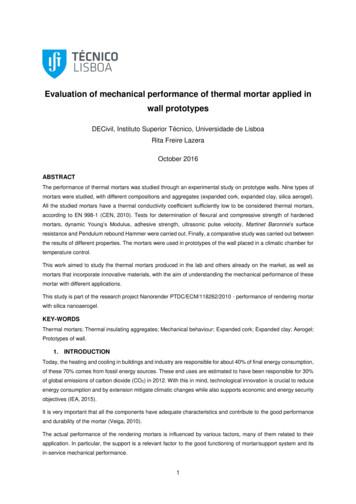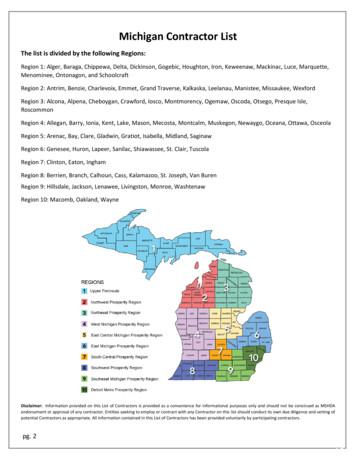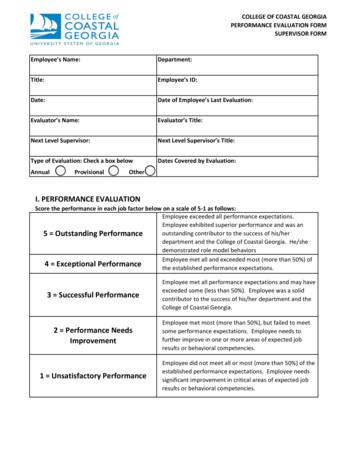Evaluation Of Mechanical Performance Of Thermal Mortar .
Evaluation of mechanical performance of thermal mortar applied inwall prototypesDECivil, Instituto Superior Técnico, Universidade de LisboaRita Freire LazeraOctober 2016ABSTRACTThe performance of thermal mortars was studied through an experimental study on prototype walls. Nine types ofmortars were studied, with different compositions and aggregates (expanded cork, expanded clay, silica aerogel).All the studied mortars have a thermal conductivity coefficient sufficiently low to be considered thermal mortars,according to EN 998-1 (CEN, 2010). Tests for determination of flexural and compressive strength of hardenedmortars, dynamic Young’s Modulus, adhesive strength, ultrasonic pulse velocity, Martinet Baronnie’s surfaceresistance and Pendulum rebound Hammer were carried out. Finally, a comparative study was carried out betweenthe results of different properties. The mortars were used in prototypes of the wall placed in a climatic chamber fortemperature control.This work aimed to study the thermal mortars produced in the lab and others already on the market, as well asmortars that incorporate innovative materials, with the aim of understanding the mechanical performance of thesemortar with different applications.This study is part of the research project Nanorender PTDC/ECM/118262/2010 - performance of rendering mortarwith silica nanoaerogel.KEY-WORDSThermal mortars; Thermal insulating aggregates; Mechanical behaviour; Expanded cork; Expanded clay; Aerogel;Prototypes of wall.1. INTRODUCTIONToday, the heating and cooling in buildings and industry are responsible for about 40% of final energy consumption,of these 70% comes from fossil energy sources. These end uses are estimated to have been responsible for 30%of global emissions of carbon dioxide (CO2) in 2012. With this in mind, technological innovation is crucial to reduceenergy consumption and by extension mitigate climatic changes while also supports economic and energy securityobjectives (IEA, 2015).It is very important that all the components have adequate characteristics and contribute to the good performanceand durability of the mortar (Veiga, 2010).The actual performance of the rendering mortars is influenced by various factors, many of them related to theirapplication. In particular, the support is a relevant factor to the good functioning of mortar/support system and itsin-service mechanical performance.1
According to Maciel et al. (1998), mechanical resistance is the property of coatings to resist to different actions, dueto abrasion, impact and hygrothermal gradients. This property depends on the nature of the aggregates and bindersand application conditions.Thus, to properly perform the functions to which they are required, the renders must fulfill certain performancerequirements, such as good workability, adherence, surface resistance, internal resistance, ability of deformation,and resistance to cracking, which were more demanding in the case of exterior renders (Silva, 2014; Flores-Colen,2009).Thermal mortars are an example of an existing solution to achieve the objectives with regard to energy efficiencyand thermal behavior of buildings walls. They are characterised by having insulating aggregates with low thermalconductivity, for example cork, expanded clay, aerogel and EPS.These thermal mortars have also to fulfill the minimum requirements for the mechanical performance. Theapplication of the mortar in the wall can condition the mechanical performance of mortar, as also the priorpreparation of the support.The thermal conductivity is a material-specific thermal property and is equal to the heat flux per unit time and perunit area that flows through a layer of unit thickness with the faces differing by one unit of temperature (MoretRodrigues et al., 2009; Rao et al., 2009). In general, the thermal conductivity of building materials depends on thetype of material, specific weight, porosity, temperature, moisture content, properties and internal structure of thematerial. The homogeneity and isotropy of material concerning the thermal conductivity should also be considered.Thus, the thermal conductivity indicates the ease of heat transfer, or more specific, of heat conduction by materials(Low et al., 2010; Abdou et al., 2013; Saleh, 2006).The mortars with thermal insulating aggregates must have application thickness over 40 mm (Veiga et al., 2012).According to EN 998-1 (CEN, 2010), this mortars are characterized by having a coefficient of thermal conductivity(λ) lower than 0.1 and 0.2 (W/(m.K)), classified as T1 and T2, respectively. In accordance with EN 998-1 (CEN,2010), the thermal mortars (T) should have compressive strength between 0.4 - 5 MPa (classes CS I and CS II),coefficient of permeability to water vapor (μ) less than 0.15 and water absorption by capillarity of W1 class (C 0.40 kg/m2. min0,5).Thermal mortars on the market, are classified as lightweight mortars, since the bulk density in hardened mortar isless than 1300 kg/m3 (EN 998-1 (CEN, 2010)).2. EXPERIMENTAL CHARACTERIZATION2.1 MORTARSThe present experimental campaign aims comparing the performance of mortars in different type of models(standardized prismatic specimens, brick models and wall prototypes).In this work, nine types of different mortars were studied. Six of which were dosed in the laboratory and three areindustrial mortars. In the production of the dosed in the laboratory mortars, it was decide to introduceadditions/admixtures for application improvement of these mortars, because these have been vertically applied.The characteristics of the different mortars used can be found in tables 1 and 2. The dosed in the laboratory mortars,contain all the same cement and vary its aggregates between granulated expanded cork, expanded clay andaerogel. A control mortar (Acon mortar) containing only sand as aggregate was produced, which serves as areference for comparison purposes. The industrial mortars consisted of two mortars with cork as main aggregate(HGC/T and IGC mortars) and one with EPS aggregate (GEPS mortar). The production of dosed in the laboratorymortars were based on the rules set out in EN 1015-2 (CEN 1998).2
Table 1 Constituents of mortar dosed in the labAdmixtures (% by weight binder)Dosed in theBinderlaboratory mortarSurfactantsCellulose etherconACEM II 32,5 N0,050,075BGCCEM II 32,5 N0,050,075CAECEM II 32,5 N0,050,075DAero/AECEM II 32,5 N1,000,075EGC/AECEM II 32,5 N0,050,075FAE/GCCEM II 32,5 N0,050,075Caption: GC-granulated Cork; AE-Expanded Clay; a/c – water/cement ratio.Sand100-Aggregate in volume 250,760,76Table 2 Constituents of industrial mortarIndustrialmortar% of replacementSize of ag.(in volume)insulator (mm)BinderAnotheraggregatesAmount ofwater (l/kg)Additions/AdmixturesGEPSLime/white cementand synthetic ligandsApplication70 a 80% EPS 1,5ni0,7 a 0,8niInd/outHGC/THydraulic lime NHL 3.5Cork (ni) 3Diatomaceousearth/clay0,55IGCPortland cement70-80% Cork1,5 a 2ni0,5natural additions;polypropylene fibers;reispercivel powder;water-repellentpowder; air deliveryagent and tractioncontrol; water retainersInd/outInd/outCaption: ni – no information.2.2 SUPPORTSTo better study the characteristics of the mortars, these were applied in wall prototypes that consist of brick modelswith 15 cm thick, with dimensions of 40x45 cm. The bricks were placed into openings in a wall (with U 0.41 W/m2ºC) of an existing climate chamber in the Construction Laboratory of the Department of Civil Engineering,Architecture and Georesources (DECivil). It is possible to see the wall in Figure 1. The cure of the mortars was atroom temperature (average 15ºC) for 28 days, putting a plastic in front of the wall, to avoid the shrinkage of themortar in the early days of healing. Surface moisting of the mortar was made at regular intervals.In addition to the prototypes, 3 standard 40 40 160 mm prismatic specimens (figure 2) and 2 ceramic hollowbricks (Figure 3) were produced for each mortar, to be tested at 28 days of age. Both elements were placed inpolyethylene bags and stored in a curing chamber at a constant temperature of 20 C 2 C and a relative humidityof 50%. The demolding of the prismatic specimens and the release of the formwork of the bricks were done after 5days of the mortar’s application, being the mortars placed again in polyethylene bags, inside the curing chamber.The removal of the bags was made 7 days after the mortar’s application, keeping the pieces in the curing chamber.Figure 1 Wall prototypesFigure 2 Standardized prismaticspecimens moldsFigure 3 Brick with formwork2.3 MORTAR APPLICATIONThe thermal mortars have been applied with a minimum thickness of 4 cm, this thickness is also recommended bythe manufacturers of industrial mortars. The application was made in two stages, i.e. two layers with a maximum of2 cm thick each. The final result of the mortars applied in the prototypes is illustrated in the Figure 4.The application of mortar in bricks models was carried out in only one layer of 4 cm, with the brick placedhorizontally, based on EN 1015-21 (CEN, 2002). On the other hand, the application of mortar in the prismaticspecimens followed the EN 1015-11 (CEN, 1998).3
Figure 4 Prototypes of wall with mortar applied2.4 TESTSThe main objective of the experimental campaign is to compare the mechanical characteristics of different thermalmortars produced and applied on different models. To this end, the following tests were performed on fresh mortar,first two tests, and hardened mortar: Bulk density of fresh mortar (EN 1015-6 (CEN, 1998)); Consistence of fresh mortar (EN 1015- 3 (CEN, 1999); Dry bulk density of hardened mortar (EN 1015-10 (CEN, 1999)); Ultrasonic pulse velocity (EN 12504-4 (CEN, 2004), equipment: PUNDIT LAB da PROCEQ); Adhesive strength of hardened rendering and plastering mortars on substrates (Pull-off) (EN 1015-12(CEN, 2000), equipment: 58- C0215/T Pull-off digital tester, load capacity 16KN da Controls); Surface hardness with pendulum rebound hammer (equipment: Schmit Pendulum Hammer type P daPROCEQ); Martinet Baronnie’s surface resistance test (measurement of the diameter of the dint); Dynamic Young’s Modulus (ASTM E1876-1 (ASTM, 2006), equipment: GrindoSonic MK5 “Industrial”,software: softwareGrindoSonic); Flexural strength of hardened mortars (EN 1015-11 (CEN, 1999), equipment: Seidner Form Test (model505/200/10 DM1) with a load cell of 10 kN); Compressive strength of hardened mortars (EN 1015-11 (CEN, 1999), equipment: Seidner Form Test(model 505/200/10 DM1) with a load cell of 200 kN);3. PRESENTATION AND DISCUSSION OF THE RESULTS3.1 MORTAR APPLICATION ON WALL PROTOTYPESIn the application of the control mortar (Acon), there have been some difficulties, due to its predominantly coarsegranulometry (aggregates between 0.5 to 2 mm), which possibly could be overcome with the adoption of morebinder or another with more percentage of finer aggregates. As such, it was necessary to apply the mortar in thinlayers and, instead of two layers, it was applied in four layers.The BGC mortar (with cork) was very elastic and unstable, resulting in detachment during application. The lack ofcohesion has made the application more multi-layered and with thinner layers. Like the Acon mortar, it was appliedin four layers, in which the last layers was no great difficulty of smoothing.The CAE mortar (with expanded clay) and DAero/AE mortar had a good workability and application. The first mortarcould have more fine aggregates. These mortars were applied in two layers of 2 cm as planned.4
There have been some difficulties in applying the E GC/AE mortar (with cork and expanded clay), due to lack ofadhesion and workability problems. This was applied in three layers, instead of the two initially planned layers. TheFAE/GC (with expanded clay and cork) had good workability, but it was applied, like the E GC/AE mortar, in three layers.The three industrial mortars (GEPS, HGC/T and IGC) presented very good workability in terms of easiness of mixingand application on wall. This behavior might be expected, since these mortars are currently marketed and thereforewith industrial application.3.2 TEST RESULTSThe results of tests made on the fresh mortar and hardened mortar applied in bricks, wall prototypes and prismaticspecimens can be consulted in Table 3.Table 3 Mechanical characteristics of mortar produced (summary).Fresh d mortarMv,e(kg/m3)PSAconBGCAECDosed 0,3IGCRc SIndustrials HGC/TPull-Off(KN/m2)Rt (MPa)PSWGEPSPendulumMartinetEd (MPa)Hammer Baronnie (cm)VMédia 21,72x0,29BW142,3778,3668,9Caption: PS – Prismatic Specimen; B – Brick; W – Wall; Rt – flexural strength; Rc – compressive strength; Ed – Dynamic Young’s Modulus; Mv,f –density of freshmortar; Mv,e – density of hardened mortar; VMédia – ultrasonic pulse velocity.In a first analysis, and taking into account the mechanical characteristics of thermal mortar applied in the differentmodels, it is possible to verify that, in comparison with the prismatic specimens, the mortar applied on the wallprototype showed a better compressive strength, much due to the suction effect of the brick. In relation to the bricks,the tests on the wall obtained values less good, this time due to the difference of conditions of application and grip.In terms of fresh mortars, the values of consistency vary between 123.6 and 189.1 mm, which shows that thesemortars are quite fluid, especially the one that contains aerogel. This happens because of the introduction ofadjuvants. The mortar that contains aerogel is the more fluid because it has more quantity of water than the othermortars. It was necessary for the aerogel to mix with the admixtures On the other hand, the bulk density had values5
between 477 and 891 kg/m3, for thermal mortars. In the same way, the mortar that contains aerogel was the onethat had the biggest value in the thermal mortars, for the same reason given to the consistency.Concerning to the dry bulk density of hardened mortar of the insulating mortars it is possible to check that the valuesvary from 387 to 722 kg/m3. According to EN 998-1 (CEN, 2010) these mortars can be classified as lightweightmortars ( 1300 kg/m3). The CAE mortar was the one that had more bulk density of all the thermal mortars, as aresult of the aggregate’s weight.Regarding to the Dynamic Young’s Modulus, the values of thermal mortars are the order of the 404-2890 MPa andas such, have a capacity of deformation exceeding current mortars, being less subject to cracking phenomena (Ed 10000 MPa, 427/05 report of LNEC (2005)). These mortars, although complying with the requirements ofresistance to compression (CSI CSII classes according to EN 998-1), they feature low Dynamic Young’s Modulus’svalues, conditioning their use, in specific situations, in particular in walls exposed to shocks (Ed 5000 MPaMERUC CSTB (1993)). Thus, the mortar with more deformability is the BGC mortar.The compressive strength of hardened thermal mortars, vary between 0.6 and 2.2 MPa in the prismatic testspecimens and 0.8 to 2.9 MPa in wall prototypes samples. It’s possible to see in Figure 5 that the results of bothtests are very different. However, the test of the prismatic specimen was made 28 days after the application of themortars, and the test of the wall samples was made 10 months after the application. The best results in the wallprototypes due to the suction effect of the brick and greater tightness in the application. Flexural strength of thethermal hardened mortars vary, in general, between 0.4 and 1.0 MPa. In comparison with the control mortar (2,26MPa), it’s possible to see the decrease of the strength in about 50%.It was possible to check that the values obtained for the surface resistance test (Martinet Baronnie), in the thermalmortars applied in the wall, were higher (between 1.2 and 2.5 cm) compared with the control mortar (0.5 cm). It waspossible to verify also, as illustrated in Figure 6, that the values of the test in mortars applied in bricks were higher(between 1.6 and 2.7 cm).3,02,01,0Protótiposde paredeWallprototypeAmostrasdos ProtótiposProvetesWall prototypesample de 1,8 1,71,61,31,31,10,90,80,60,80,9Martinet Baronniediameter of the dint(cm)Compressive strength(MPa)4,00,0BCDEFDosed in naisGHI2,0 2,22,01,00,51,61,42,11,7 1,82,11,51,91,6 1,71,20,0BCDEArgamassasTradicionaisDosedin laboratorymortarFigure 5 Compressive strength of test specimens prismaticand samples taken from the prototypes of the wall2,5 2,70,7AArgamassasTérmicasIndustrial dustrialmortarIndustriaisFigure 6 Diameters of the dint impact of the MartinetBaronnie in mortar applied in brick and wall prototypesIn the Pendulum Hammer test, the thermal mortars had a Pendulum Hammer’ value under 100 (between 100 and77.1) in the tests on the wall. The values obtain in the test done in the mortar applied in brick (between 74.2 and82.8) were smaller than the results of the test in the wall (Figure 7), where the rigidity of the support was higher.In relation to the values of adhesive strength to support, in applied thermal mortar to brick, ranged from 0.05 to 0.30MPa. In prototypes of the wall it was found the impossibility of conducting some tests, but those that were possibleto obtained, the values were between 0.01 and 0.29 MPa. It’s difficult to compare both models (Figure 8), whereasthere aren’t values for all mortars applied in the wall; it is only possible to check that the industrial mortars areprepared to be applied in walls. Taking into account existing requirements and fields of application recommendedby the manufacturers of the respective industrial mortars (can be used for the rehabilitation), the values obtainedcan be considered acceptable in some cases (0.1-0.3 MPa to adhesive ruptures). It is still possible to conclude that6
in the mortars assessed in the laboratory, there is lack of adhesive strength, soon need an improvement in thisrespect.112,8100,0Adhesive strength(MPa)BrickTijoloPrototiposde paredeWallprototype150,0 117,3100,296,593,492,591,190,383,075,082,8 77,1 78,5 74,280,0 0,300,29 0,290,200,2000,140,09 0,08 0,100ABCDEDosedin edin sde sFigure 8 Comparison of the mortars adhesive strength applied inbrick and in wall prototypesFigure 7 Pendulum Hammer values in the mortar appliedin prototypes and brick wall.Seen to have conducted the determination of ultrasonic pulse velocity in all of the models (with direct and indirectmethod), it is possible to check that in direct method of this test (1185 to 2266 m/s) (Figure 9), the velocity is smallerthan the values obtain in the wall and bricks, much due to the mortar applied in wall and brick have received
coefficient of permeability to water vapor (μ) less than 0.15 and water absorption by capillarity of W1 class (C 0.40 kg/m2. min0,5). Thermal mortars on the market, are classified as lightweight mortars, since the bulk density in hardened mortar is . (ASTM E1876-1 (
Mechanical Contractor Redmon Heating & Cooling Grandville (616) 534-9330 Mechanical Contractor D.K.S. Mechanical, Inc. Marne (616) 677-6001 Mechanical Contractor AirFlow Mechanical Services LLC Wyoming (616) 752-0320 Mechanical Contractor Van Antwerp's Mechanical, Inc. Holland (616) 772-1112 Mechanical Contractor Grand Rapids Heating and .
The Mechanical Foundation Series is a compulsory basic course for mechanical majors. It covers a wide range of courses, including mechanical drawing, mechanical principles, mechanical design, mechanical manufacturing foundation, engineering materials and tolerance technology measurement [1]. It is a learning
Performance Evaluation Plan Reference Annex XIII 1. ‘ To plan, continuously conduct and document a performance evaluation, the manufacturer shall establish and update a performance evaluation plan. The performance evaluation plan shall specify the characteristics and the perfor
POINT METHOD OF JOB EVALUATION -- 2 6 3 Bergmann, T. J., and Scarpello, V. G. (2001). Point schedule to method of job evaluation. In Compensation decision '. This is one making. New York, NY: Harcourt. f dollar . ' POINT METHOD OF JOB EVALUATION In the point method (also called point factor) of job evaluation, the organizationFile Size: 575KBPage Count: 12Explore further4 Different Types of Job Evaluation Methods - Workologyworkology.comPoint Method Job Evaluation Example Work - Chron.comwork.chron.comSAMPLE APPLICATION SCORING MATRIXwww.talent.wisc.eduSix Steps to Conducting a Job Analysis - OPM.govwww.opm.govJob Evaluation: Point Method - HR-Guidewww.hr-guide.comRecommended to you b
Section 2 Evaluation Essentials covers the nuts and bolts of 'how to do' evaluation including evaluation stages, evaluation questions, and a range of evaluation methods. Section 3 Evaluation Frameworks and Logic Models introduces logic models and how these form an integral part of the approach to planning and evaluation. It also
PERFORMANCE EVALUATION FORM SUPERVISOR FORM I. PERFORMANCE EVALUATION Score the performance in each job factor below on a scale of 5-1 as follows: Type of Evaluation: Check a box below Dates Covered by Evaluation:
for mechanical engineers in tamilnadu, list of government jobs for mechanical engineers in karnataka, list of government jobs for diploma mechanical engineer, list of govt jobs for mechanical engineers T), MCA, Electronics and Communication (ECE), Mechanical, Electrical and . l Design automation -
Formal annual evaluation of performance The formal annual evaluation of employee performance and planning development comprises four parts: 1. Identifying and agreeing on Key Performance Indicators, and any goals and responsibilities to implement the service's QIP. 2. Preparing for the meeting. 3. The annual performance evaluation meeting. 4.























